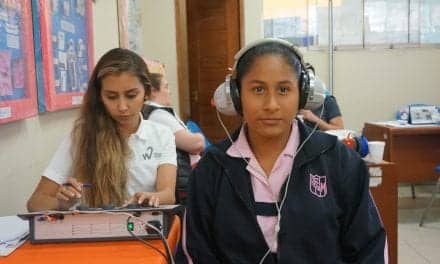BlogPage | April 2014 Hearing Review
By Gael Hannan
The following is an abridged version of Gael Hannan’s February 11, 2014 blog at her Better Hearing Consumer column at HearingHealthMatters.com. — David Kirkwood, HearingHealthMatters editor
I don’t pretend to be a hearing care professional. But for anyone looking for non-biased, trial-and-error insider advice about hearing aids, I reckon that experience is worth at least a year or two of audiology courses. Maybe even a degree. Because after almost 40 years of hearing aid use, I’ve learned an important thing or two about hearing aids:
#1: After you have a shower, or go swimming, or after any activity where your ears have been underwater, wait half an hour before putting in your hearing aid. The ear canal and surrounding areas should be as dry as possible to prevent moisture steaming up your technology. Wet stuff is simply not good for expensive aids and cochlear implants.
Should you, unfortunately, soak your head with your hearing aids in—being caught in a downpour, perhaps, or having your head submersed in the toilet (we won’t ask)—you need to act quickly. The first step is remove your ears from the water as soon as possible. Then, remove the battery and place the aid in a dry-aid kit. Do not use a hot air dryer, oven, or microwave. As you sit watching it dry out for a few hours, keep your fingers tightly crossed, as if in prayer. If the hearing aid fails to work after that, or if you hear static, call your hearing care provider. Good luck.
#2: Do not believe your audiologist when she tells you not to put anything in your ear that’s smaller than your elbow. She doesn’t really mean it. After all, the hearing aid she sold me is significantly smaller than my elbow. Apart from that, you can believe everything else she says. Hang on…is that $4,000 latest hearing aid marvel really the best and only one suitable for your hearing loss? Ask questions.
#3: While you’re at it, ask about telecoils (t-switch), because your audiologist or hearing instrument specialist may forget to mention it. If he says you don’t need telecoils, ask why. He may say, “Well, you should buy an accessibility kit designed to connect your aid to your TVs, phones, and doorbells.” Then you can say, “Well, isn’t that nice—but sometimes I like to leave the house and I’ve heard the t-switch will connect me in all sorts of places.” And then add, “Since I’m already paying a small fortune for this hearing aid, why not throw in that handy-dandy house kit for free?”
#4: When you take out your hearing aids or CI, always put them in a safe place, and preferably the same place. A story about the “safe” thing: I put my first-ever hearing aid on my bedside table, where it lay naked and open to the elements. One such element was a very large dog, who ate it. Most of it, anyway; I was able to retrieve bits of springs, screws, and casing that clung from the curly hairs around his doggie-mouth. Since that night, my hearing aids sleep in a dry-aid jar.
Putting technology in the same place cuts down on the inevitable panic when you can’t find it. I’m reminded of this every year when I watch a certain CI user, my friend and perennial roommate at hearing loss conferences, looking for her batteries in a cluttered hotel room. She eventually finds them, but the show is always entertaining.
#5: Every time you get new hearing aids, it will be like the first time. Everything will be loud. People chewing their food sound like pigs at a trough. A human nose whistles like a steam engine. The clattering of knives and forks will send you through the roof and you’ll ask your family to eat with their hands.
What I’m saying is—brace yourself. Things will be quieter in a month. But then, because sounds aren’t as loud, you’ll worry that the technology has destroyed a few more decibels of your hearing. Trust me, it hasn’t.
#6: Show the love to your hearing aids and CIs, and they’ll love you back. Or maybe it’s the other way around. Regardless, a beautiful and mutually respectful relationship is definitely possible; like any relationship—there’s good stuff and the not so great stuff. There will be days when you think, I’m so done with this thing! But persevere because, if you need them, life is better with hearing aids or cochlear implants.
#7: When you see a stranger with hearing technology, pause a moment before commenting. Pointing to your own ears and saying, “Hi there, harda-hearing too, eh?” is to risk a negative reaction. He or she may be at a different stage of the hearing loss journey, and having their aids or implant pointed out might be embarrassing or grumpy-making. But if you feel comfortable in making the connection, your positive attitude may just make that person’s day—and yours.
#8: A public service message for your significant other. Here’s what a cranky spouse-parent-friend should not say to a person with hearing loss who’s struggling in a conversation: “Have you got your hearing aids in?!” Because we usually do, and when we say, “Uh, yes,” what’s your next line going to be?
#9: Don’t try to repair your own hearing devices unless you have taken a course. You can change batteries and wax guards, and use that little brush to clean the outside. But do not, under any circumstances, open it up and use tweezers to remove what looks to you like simple debris. There’s a high probability the guck is attached to a trip wire that will destroy the whole damn thing. Another no-no is putting the bottom of an in-the-ear aid between your lips and trying to suck out the earwax. You may get more than you expected.
#10: If you don’t yet use any technology, learn about your hearing loss. Learn about hearing aids and other technology. Get some. And then, read this again or call me; I’m here for ya.
Gael Hannan is a writer, actor, and public speaker who lives in Toronto and grew up with a progressive hearing loss that is now severe-to-profound. She is a director on the national board of the Canadian Hard-of-hearing Association (CHHA) and her advocacy includes speech reading instruction, hearing awareness, workshops for youth with hearing loss, and work on hearing access committees.
Original citation for this article: Hannan G. Nitty-gritty tips from a hearing aid user. Hearing Review. 2014;21(4):12.





